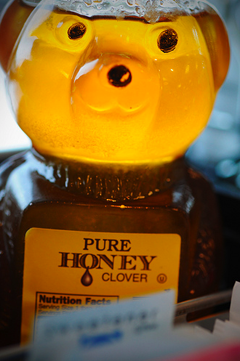That Honey You Thought Maybe Wasn't Honey Is Actually Probably Honey
Just in case you’ve been staring numbly and accusingly at the plastic bear in your pantry, after a recent report that most honey isn’t really honey, and is instead “ultrapurified,” rest easy! Another report says it probably is the real deal.
The original report from Food Safety News, which Consumerist and other media outlets made mention of, said supermarket honey for the most part was filtered of pollen in a purification process that altered its essence, rendering it un-honey.
But now NPR’s food blog, “The Salt,” says it ain’t so. They checked in with the honey companies, academics and other experts in the industry, and came up with some interesting insights.
First of all, missing pollen does not imply “ultrapurification.” Raw honey is treated with diatomaceous earth and then filtered to remove all the pollen, along with dust, bees’ wings, and the aforementioned earth.
This process is due to American’s collective aversion to crystallization in honey, which happens faster if it’s not filtered. It does not, however, alter the honey and change it into faux honey.
“Consumers don’t tend to like crystallized honey,” says Jill Clark, vice president for sales and marketing at Dutch Gold. “It’s very funny. In Canada, there’s a lot of creamed honey sold, and people are very accustomed to honey crystallizing. Same in Europe. But the U.S. consumer is very used to a liquid product, and as soon as they see those first granules of crystallization, we get the phone calls: ‘Something’s wrong with my honey!'”
This all means that even if hone on the store shelf doesn’t have pollen, it’s still honey, it’s just filtered. So honey it up, honey lovers.
*Thanks to Consumerist reader Aron D. for the tip!
Previously: That Honey In Your Cabinet Probably Isn’t Honey
Relax, Folks. It Really Is Honey After All [NPR]
Want more consumer news? Visit our parent organization, Consumer Reports, for the latest on scams, recalls, and other consumer issues.


